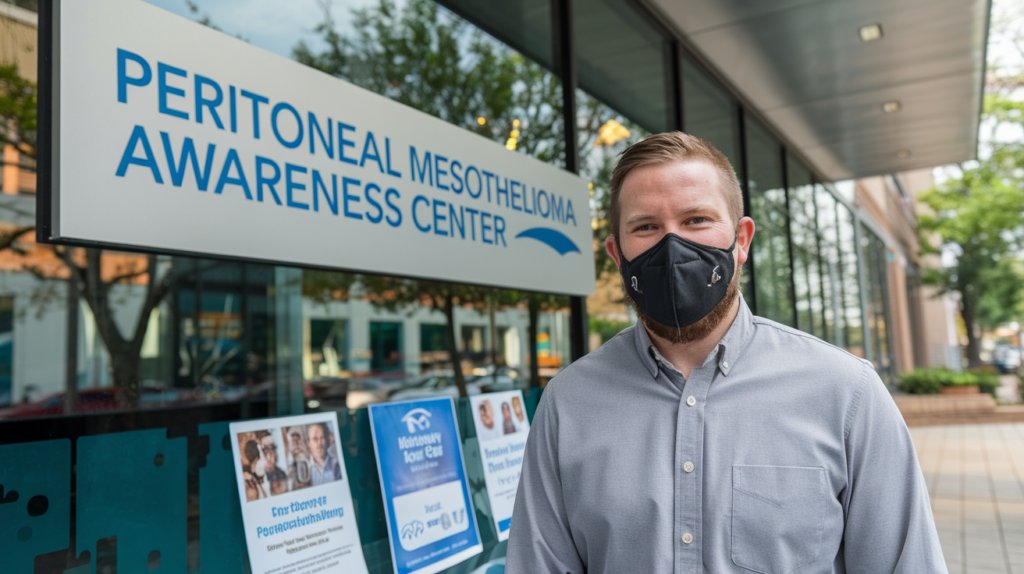Introduction to Peritoneal Mesothelioma
Definition and Explanation of Peritoneal Mesothelioma
Peritoneal Mesothelioma is a rare and aggressive form of cancer that originates in the peritoneum, the thin membrane lining the abdominal cavity. This cancer is primarily caused by exposure to asbestos, where microscopic fibers are ingested and migrate to the peritoneum, leading to inflammation and the development of malignant tumors. Understanding this condition is crucial due to its rarity and the challenges it poses in diagnosis and treatment.

Incidence and Prevalence Statistics
Peritoneal Mesothelioma accounts for approximately 10-20% of all mesothelioma cases, making it less common than pleural mesothelioma, which constitutes about 75% of diagnoses. This form of cancer is more prevalent in men, often linked to occupational asbestos exposure. The incidence rate varies geographically, with higher occurrences in regions with significant industrial asbestos use.
Comparison with Other Types of Mesothelioma (Pleural, Pericardial, and Testicular)
Peritoneal Mesothelioma differs显著 from other types in location, symptoms, and treatment approaches. Pleural mesothelioma affects the lung lining, presenting symptoms like chest pain and shortness of breath, while peritoneal mesothelioma causes abdominal pain and swelling. Pericardial mesothelioma, affecting the heart lining, and testicular mesothelioma, which is extremely rare, have distinct presentations and treatment options. Cytoreductive surgery combined with heated intraperitoneal chemotherapy is a key therapy for peritoneal cases, unlike pleural treatments which may involve pleurectomy or chemotherapy.
In conclusion, Peritoneal Mesothelioma, while rare, requires specialized care and awareness. Its comparison with other mesothelioma types highlights the importance of early detection and tailored treatment plans.
2. Causes of Peritoneal Mesothelioma
Primary Cause: Asbestos Exposure
The primary cause of Peritoneal Mesothelioma is exposure to asbestos, a group of naturally occurring minerals that were widely used in various industries due to their heat-resistant properties. When asbestos-containing materials are disturbed, they release microscopic fibers into the air, which can be inhaled or ingested. These fibers can travel through the lymphatic system or the digestive tract, eventually reaching the peritoneum, the lining of the abdominal cavity. Over time, the accumulation of asbestos fibers in the peritoneum leads to chronic inflammation and genetic mutations in the mesothelial cells, which can result in the development of Peritoneal Mesothelioma.

Pathway of Asbestos Fibers to the Peritoneum
Asbestos fibers typically enter the body through inhalation or ingestion. Once inhaled, some fibers can be carried by the lymphatic system to the peritoneum. Additionally, fibers ingested through contaminated food or water can pass through the digestive tract and reach the peritoneum. In the peritoneal cavity, these fibers cause irritation and inflammation, leading to the formation of scar tissue and, potentially, malignant tumors. The latency period between asbestos exposure and the development of Peritoneal Mesothelioma can range from 20 to 50 years, making it challenging to diagnose in the early stages.
Other Potential Risk Factors and Their Significance
While asbestos exposure is the predominant risk factor for Peritoneal Mesothelioma, other potential factors have been identified, although their significance is less established. These include:
Genetic Predisposition: Some studies suggest that individuals with certain genetic mutations may be more susceptible to developing mesothelioma, though this is not well understood.
Radiation Exposure: High doses of radiation, particularly in the abdominal area, have been linked to an increased risk of Peritoneal Mesothelioma, though this is rare.
SV40 Virus: Some research indicates that exposure to the Simian Virus 40 (SV40) may be associated with an increased risk of mesothelioma, but this connection is still under investigation.
It is important to note that these factors are significantly less impactful compared to asbestos exposure. The majority of Peritoneal Mesothelioma cases are directly attributed to asbestos, emphasizing the critical need for asbestos avoidance and proper safety measures in at-risk environments.
3. Symptoms of Peritoneal Mesothelioma
Common Symptoms: Abdominal Pain, Swelling, Nausea
Peritoneal Mesothelioma often presents with persistent abdominal pain, which may be dull or achy and worsens over time. Swelling in the abdomen, known as ascites, is another common symptom, leading to abdominal distension. Nausea, and sometimes vomiting, can also occur, affecting digestion and overall comfort.

Less Common Symptoms: Weight Loss, Fatigue
Less commonly, patients may experience unintentional and significant weight loss, which could be due to reduced appetite or changes in the body’s metabolism. Fatigue, a persistent feeling of tiredness not relieved by rest, is another less common symptom, potentially linked to the disease’s impact on the body or associated anemia.
Challenges in Early Detection Due to Nonspecific Symptoms
Early detection of Peritoneal Mesothelioma is challenging due to the nonspecific nature of its symptoms. Abdominal pain and swelling can mimic less serious conditions such as irritable bowel syndrome or ovarian cancer, leading to misdiagnosis or delayed diagnosis. The importance of considering a patient’s history of asbestos exposure cannot be overstated when these symptoms present. A thorough diagnostic workup is essential to rule out other causes and confirm the diagnosis. As the disease progresses, symptoms may become more severe, emphasizing the need for early medical evaluation, particularly in individuals with a history of asbestos exposure.
4.Diagnosis of Peritoneal Mesothelioma
Imaging Tests: CT Scans, MRI, Ultrasound
Imaging tests play a crucial role in the diagnosis of Peritoneal Mesothelioma by helping visualize the abdomen and detect abnormalities such as tumors or fluid buildup. CT scans provide detailed images of the abdomen, aiding in the identification of tumors or fluid accumulation. MRI, on the other hand, offers better soft tissue contrast, which is useful for assessing the extent of the tumor. Ultrasound is particularly helpful for detecting fluid in the abdomen and can guide biopsy procedures for more accurate sampling.
Biopsy Procedures: Types and Purposes
Biopsy procedures are essential for confirming the presence of cancer cells and determining the type of mesothelioma. A needle biopsy involves inserting a needle to collect fluid or tissue samples, while laparoscopic biopsy uses laparoscopy to obtain tissue samples. These procedures are crucial for confirming the diagnosis and guiding treatment decisions.
Laparoscopy: Diagnostic and Exploratory Roles
Laparoscopy is a surgical procedure that involves inserting a small camera into the abdomen. Its diagnostic role includes visual inspection of the peritoneum and assessment of tumor spread. Additionally, it plays an exploratory role by helping in staging the cancer and determining the most appropriate treatment options.
Diagnostic Challenges and the Importance of a Multidisciplinary Approach
Diagnosing Peritoneal Mesothelioma is challenging due to its nonspecific symptoms, which can lead to misdiagnosis. A multidisciplinary approach is crucial, involving specialists such as radiologists, pathologists, and oncologists. This collaborative approach enhances the accuracy of diagnosis and treatment planning, ensuring that patients receive the most appropriate care.
5. Treatment Options for Peritoneal Mesothelioma
Surgery: Cytoreduction with Heated Intraperitoneal Chemotherapy (HIPEC)
Surgery is a cornerstone of treatment for Peritoneal Mesothelioma, with cytoreduction combined with heated intraperitoneal chemotherapy (HIPEC) being a prominent approach. Cytoreduction involves the removal of as much tumor tissue as possible from the abdominal cavity. Following surgery, HIPEC is administered, where chemotherapy drugs are delivered directly into the abdomen at a higher temperature than traditional chemotherapy. This targeted delivery aims to kill any remaining cancer cells, offering a more localized and effective treatment compared to systemic chemotherapy alone.
Chemotherapy: Systemic and Targeted Therapies
Chemotherapy plays a significant role in managing Peritoneal Mesothelioma. Systemic chemotherapy involves the use of drugs like pemetrexed and cisplatin, which circulate throughout the body to target cancer cells. Additionally, targeted therapies are being explored to specifically attack cancer cells with minimal damage to healthy tissues. These treatments are often used in combination with surgery or radiation, depending on the stage and spread of the cancer.
Radiation Therapy: Use and Limitations
Radiation therapy for Peritoneal Mesothelioma is used to target specific areas of tumor growth. However, due to the proximity of sensitive organs in the abdominal cavity, radiation dosage and targeting are challenging. While it can help control tumor growth and relieve symptoms, its use is often limited by the risk of damaging surrounding tissues. Nonetheless, advancements in radiation techniques are improving its efficacy and safety in this context.
Emerging Treatments: Immunotherapy and Clinical Trials
Immunotherapy is an emerging field offering new hope for Peritoneal Mesothelioma patients. This approach involves enhancing the body’s immune system to fight cancer more effectively. Clinical trials are investigating various immunotherapeutic agents, such as checkpoint inhibitors, which have shown promise in some cases. Participation in these trials can provide access to cutting-edge treatments and contribute to the development of new therapies.
In summary, the treatment of Peritoneal Mesothelioma is multifaceted, involving surgery, chemotherapy, radiation therapy, and emerging treatments like immunotherapy. The choice of treatment depends on the stage of the cancer, the patient’s overall health, and the specific characteristics of the tumor. A multidisciplinary approach, combining these treatments, is often the most effective strategy to manage this challenging cancer.
6. Prognosis and Survival Rates
Life Expectancy and Factors Influencing Prognosis
The prognosis for Peritoneal Mesothelioma is generally challenging, but it can vary significantly depending on several factors. On average, patients may have a life expectancy ranging from 12 to 24 months, though some may live longer with aggressive treatment. Key factors influencing prognosis include:
- Stage of Cancer: Early-stage diagnosis often offers better treatment options and prognosis.
- Treatment Response: How well a patient responds to treatments like surgery, chemotherapy, and radiation.
- Age and Overall Health: Younger patients and those in better general health tend to fare better.
- Genetic Factors: Certain genetic markers may influence how the disease progresses.
Comparison with Other Types of Mesothelioma
Compared to other types of mesothelioma, Peritoneal Mesothelioma often has a slightly better prognosis than Pleural Mesothelioma. While Pleural Mesothelioma, which affects the lining of the lungs, typically has a median survival of around 12 months, Peritoneal Mesothelioma patients may see median survivals of 2 to 4 years, especially with treatments like cytoreductive surgery with HIPEC (heated intraperitoneal chemotherapy). Pericardial and testicular mesothelioma are even rarer and generally have poorer prognoses due to their locations and challenges in treatment.
Recent Improvements in Survival Rates and Treatment Outcomes
Recent advancements in treatment have shown promising improvements in survival rates for Peritoneal Mesothelioma. Notably, the combination of cytoreductive surgery and HIPEC has significantly enhanced outcomes for many patients. Additionally, emerging therapies, such as immunotherapy, are being explored in clinical trials and have shown potential in prolonging survival and improving quality of life. For instance, some studies have reported increased median survival times with the use of immune checkpoint inhibitors.
Overall, while Peritoneal Mesothelioma remains a serious diagnosis, ongoing research and new treatment approaches are providing hope for improved prognosis and survival rates. Patients are encouraged to consult with specialists to explore the most effective treatment options available.
7. Prevention of Peritoneal Mesothelioma
Strategies to Prevent Asbestos Exposure
Preventing asbestos exposure is the most effective way to reduce the risk of developing Peritoneal Mesothelioma. Asbestos fibers, when inhaled or ingested, can lead to the development of this aggressive cancer. Therefore, it is crucial to implement strategies that minimize or eliminate exposure to asbestos. This includes proper handling and disposal of asbestos-containing materials, using protective equipment such as respirators and gloves, and ensuring safe demolition practices in buildings that may contain asbestos. Regular inspections and maintenance of buildings to identify and manage asbestos-containing materials are also essential preventive measures.
Occupational Safety Measures and Regulations
Occupational exposure is a significant risk factor for Peritoneal Mesothelioma, particularly in industries such as construction, shipbuilding, and manufacturing. Regulatory bodies like the Occupational Safety and Health Administration (OSHA) have established standards to protect workers from asbestos exposure. These regulations include setting permissible exposure limits, requiring employers to provide protective equipment, and mandating asbestos awareness training. Compliance with these regulations is crucial to reducing the incidence of asbestos-related diseases among workers. Additionally, regular health screenings for at-risk employees can aid in early detection and intervention.
Public Awareness and Education
Public awareness and education are vital components of preventing Peritoneal Mesothelioma. Many people are unaware of the risks associated with asbestos exposure, both in the workplace and in their homes. Educating the public about the dangers of asbestos, how it can be encountered in older buildings, and the importance of professional asbestos removal can significantly reduce exposure risks. Healthcare providers also play a crucial role in educating patients about asbestos hazards and the importance of avoiding exposure. Furthermore, raising awareness about the legal aspects, such as bans on asbestos use in certain countries, can empower individuals to advocate for safer environments and policies.
In summary, preventing Peritoneal Mesothelioma requires a multi-faceted approach that includes rigorous strategies to prevent asbestos exposure, adherence to occupational safety regulations, and widespread public education. By addressing these areas comprehensively, we can mitigate the long-term health implications associated with asbestos exposure and reduce the incidence of this devastating disease.
8. Support and Resources for Patients and Families
Support Groups and Counseling Services
Patients and families coping with Peritoneal Mesothelioma can find solace and strength through various support networks. National organizations such as the Mesothelioma Applied Research Foundation and the American Cancer Society offer both online and in-person support groups, providing a platform for sharing experiences and coping strategies. Online communities and forums, such as those found on social media platforms, also allow for peer support and connection. Professional counseling services, including therapists specializing in cancer support, are available to help manage the emotional challenges. Additionally, hotlines and helplines provide immediate assistance and guidance.
Financial Assistance Options
Managing the financial burden of Peritoneal Mesothelioma is a significant concern for many patients and families. Government programs like Medicaid and Medicare can assist with medical expenses, while non-profit organizations offer financial aid specifically for mesothelioma patients. Legal resources are also available for those seeking compensation from asbestos companies. Furthermore, patient assistance programs from pharmaceutical companies can help alleviate the cost of medications. It is essential to explore these options and understand the application processes to access the necessary support.
Reliable Information Sources and Educational Resources
Staying informed is crucial for making informed decisions about treatment and care. Authoritative websites such as the National Cancer Institute and Mayo Clinic provide comprehensive information on Peritoneal Mesothelioma. Peer-reviewed journals and publications offer the latest research findings, while educational videos and webinars explain disease progression and treatment options in an accessible manner. Books and guides written by medical professionals and survivors offer practical advice and emotional support, helping patients and families navigate this challenging journey.
9. Stages of Peritoneal Mesothelioma
Explanation of Staging Systems (e.g., TNM Staging)
Staging is a crucial process in cancer management that helps determine the extent of the disease and guide treatment decisions. For Peritoneal Mesothelioma, the TNM staging system is commonly used. TNM stands for Tumor, Node, and Metastasis:
- T (Tumor): Describes the size and location of the primary tumor.
- N (Node): Indicates whether the cancer has spread to nearby lymph nodes.
- M (Metastasis): Shows if there is any spread to distant parts of the body.
This system helps classify the cancer into stages, which are essential for planning treatment and predicting prognosis.
Implications of Each Stage on Treatment and Prognosis
Peritoneal Mesothelioma is typically staged using the TNM system, which can be complex due to the nature of the disease. Here’s a general overview of the stages and their implications:
Stage I: The cancer is localized, with the primary tumor confined to the peritoneum. Treatment options may include surgery, possibly combined with chemotherapy or radiation. Prognosis is generally better at this stage, with longer survival rates.
Stage II: The tumor has grown and may have spread to nearby organs or lymph nodes. Treatment might involve a combination of surgery, chemotherapy, and radiation. Prognosis is still relatively favorable but less optimistic than Stage I.
Stage III: The cancer has spread more extensively within the abdomen, affecting multiple organs and possibly lymph nodes. Treatment may focus on alleviating symptoms and improving quality of life, though some patients may still undergo aggressive treatments. Prognosis is poorer, with shorter survival rates.
Stage IV: The cancer has metastasized to distant parts of the body. At this stage, treatment is often palliative, aiming to manage symptoms and provide comfort. Prognosis is the poorest, with limited options for extending life.
It’s important to note that staging is not static; it can change as the cancer progresses or responds to treatment. Patients and families should maintain regular consultations with healthcare providers to monitor the disease’s stage and adjust treatment plans accordingly.
In conclusion, understanding the staging of Peritoneal Mesothelioma is vital for determining the most appropriate treatment and managing expectations regarding prognosis. Patients should seek comprehensive care and support to navigate this challenging journey.
10. Emotional and Psychological Impact
Effects on Patients and Their Families
A diagnosis of Peritoneal Mesothelioma can have profound emotional and psychological effects on both patients and their families. For patients, the emotional journey often includes anxiety, depression, and fear of the unknown. The physical symptoms and the stress of treatment can further exacerbate these feelings, significantly impacting daily life and relationships. Patients may also experience a sense of isolation due to the rarity of the disease, which can limit access to specialized support groups.
For families, the emotional burden is equally significant. The stress of caregiving, combined with the fear of losing a loved one, can lead to grief and anticipatory grief. Financial and logistical challenges add to the strain, often altering family dynamics and creating additional emotional stress.
Coping Strategies and Available Support Networks
Coping with the emotional and psychological impact of Peritoneal Mesothelioma requires a multifaceted approach. Patients and families can benefit from therapy and counseling, which provide tools to manage anxiety and depression. Support groups, both in-person and online, offer a sense of community and understanding, helping to reduce feelings of isolation.
Mindfulness and relaxation techniques, such as meditation and deep breathing exercises, can also be effective in managing stress. Practical coping mechanisms, including financial planning and legal advice, can alleviate some of the logistical burdens.
Professional support, such as psychologists and social workers, is crucial in navigating the emotional landscape of the disease. Palliative care services can further enhance quality of life by addressing both physical and emotional needs.
In conclusion, recognizing and addressing the emotional and psychological impact of Peritoneal Mesothelioma is essential for improving the quality of life for patients and their families. Seeking help from available resources and support networks can make a significant difference in coping with this challenging diagnosis.
11. Research and Future Directions
1. Current Studies and Clinical Research
Ongoing clinical trials are exploring various approaches to improve the treatment of peritoneal mesothelioma. These studies often focus on combination therapies that integrate chemotherapy, surgery, and emerging treatments. For instance, heated intraperitoneal chemotherapy (HIPEC) is being refined to enhance its efficacy when combined with cytoreductive surgery. Additionally, immunotherapy is a significant area of investigation, with trials assessing the potential of PD-1 inhibitors and other immune checkpoint inhibitors to combat the disease.
2. New Treatments Being Explored
Emerging treatments for peritoneal mesothelioma include immunotherapy, targeted therapies, and personalized medicine. Immunotherapy aims to harness the body’s immune system to fight cancer, with ongoing research exploring its effectiveness in this context. Targeted therapies focus on specific genetic mutations within the tumor, offering a more personalized approach to treatment. Gene therapy is also being explored as a potential future direction, although it is still in the early stages of development.
3. Advances in Diagnosis and Prognosis
Recent advances in diagnosis and prognosis include the development of new imaging techniques and biomarkers. Improved imaging technologies are being researched to detect peritoneal mesothelioma at an earlier stage, enhancing treatment outcomes. Biomarkers, which can indicate the presence of cancer or predict its aggressiveness, are also under investigation. These advancements could lead to more accurate staging and better-informed treatment decisions.
In conclusion, while peritoneal mesothelioma remains a challenging cancer to treat, ongoing research and clinical trials offer hope for improved outcomes. The exploration of new treatments, advances in diagnosis, and the importance of multidisciplinary approaches highlight the dynamic nature of this field. Continued support and funding are crucial to accelerating progress and providing better care for patients.
12. Legal Aspects and Seeking Compensation
Overview of Asbestos-Related Litigation
Asbestos-related litigation is a significant aspect of legal action for individuals diagnosed with peritoneal mesothelioma. This type of litigation involves legal cases brought against companies that manufactured, distributed, or used asbestos products. Historically, these cases have led to substantial compensation for victims and their families. Notable cases include class-action suits and individual lawsuits that have highlighted the negligence of asbestos companies in protecting workers and consumers.
Patient Rights and Legal Recourse
Patients diagnosed with peritoneal mesothelioma have specific rights, including the right to seek compensation for their suffering. This compensation can be pursued through various legal avenues, such as filing a lawsuit against asbestos companies or seeking workers’ compensation. Patients also have the right to access their medical records and to be informed about their legal options. Additionally, legal aid and support groups are available to assist patients and their families through this challenging process.
Steps to Seek Compensation for Asbestos Exposure
Seeking compensation for asbestos exposure involves several key steps:
Consult with a Specialist Attorney: It is crucial to consult with an experienced asbestos attorney who can provide tailored advice based on individual circumstances.
Gather Evidence: Collect evidence of asbestos exposure, including employment records, medical records, and testimonies from witnesses.
File a Lawsuit: Depending on the jurisdiction, file a lawsuit within the statute of limitations to avoid losing the right to claim compensation.
Pursue Compensation: Compensation may include monetary awards for medical expenses, loss of wages, and pain and suffering.
Challenges in Asbestos Litigation
Challenges in asbestos litigation include proving exposure and accounting for the disease’s latency period. Asbestos companies may defend themselves by arguing against the direct link between their products and the patient’s condition. Despite these challenges, many patients successfully seek compensation with the help of skilled legal representation.
In conclusion, understanding the legal aspects of peritoneal mesothelioma is crucial for patients and their families. By knowing their rights and the steps to seek compensation, they can navigate the legal process with greater confidence and seek the justice and support they deserve.
Conclusion
In summary, peritoneal mesothelioma is a rare and aggressive cancer primarily caused by asbestos exposure, affecting the lining of the abdominal cavity. With an incidence rate of about 10-20% of all mesothelioma cases, it presents unique challenges in diagnosis and treatment compared to other types like pleural, pericardial, and testicular mesothelioma. Early detection is crucial, yet often hindered by nonspecific symptoms such as abdominal pain and swelling.
The article has highlighted various diagnostic methods, including imaging tests and biopsy procedures, as well as treatment options ranging from surgery and chemotherapy to emerging therapies like immunotherapy. Prognosis varies significantly based on the stage of cancer and individual factors, underscoring the importance of personalized care plans.
Preventive measures, particularly reducing asbestos exposure, are vital in combating this disease. Additionally, support resources, both emotional and financial, play a pivotal role in enhancing the quality of life for patients and their families.
As research continues to advance, there is hope for improved treatments and diagnostic techniques. Patients and families must remain informed and advocate for their rights, including seeking legal recourse for asbestos exposure.
In conclusion, while peritoneal mesothelioma remains a formidable challenge, early detection, comprehensive care, and robust support systems are key to improving outcomes. The ongoing fight against this disease relies on continued research, awareness, and advocacy, offering hope for future advancements and better lives for those affected.



One Comment